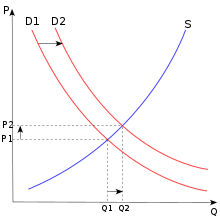Which of the following is an example of derived demand?

Which of the following is an example of derived demand?
- As the demand for hot dogs increases, the demand for hot dog buns increases.
- The supply of the meat that goes into hot dogs will affect the quantity demanded of the meat during the summer.
- As demand for hot dogs increases during the summer, the demand for the meat that goes into hot dogs will increase.
- The quantity demanded of hot dogs during the summer is affected by the supply of hot dogs.
Answer; 3. As demand for hot dogs increases during the summer, the demand for the meat that goes into hot dogs will increase.
Elevate Your Writing with Our Free Writing Tools!
Did you know that we provide a free essay and speech generator, plagiarism checker, summarizer, paraphraser, and other writing tools for free?
Access Free Writing ToolsStudying economics has several benefits but this does not come smoothly. Students studying economics encounter several challenges when completing their assignments due to the complexity of the subject. Seeking online economics homework help from a reputable service like Gudwriter will help you sail through your economics course. Seek help and quarantee yourself good grades.
What is Derived Demand?
Derived demand is a widely used economic model. Derived demand results in demand for an intermediate good or factor of production which occurs because of an increase in demand of another final or intermediate good. An example of derived demand is when the demand for fuel increases because of an increase in Car purchases.
Types of Derived Demand
There are two types of derived demand:
1. Direct derived demand
This type of demand results in an increase in the raw materials used to produce the final good. An example of this is the demand for tires which results in an increase in the demand for rubber.
2. Indirect derived demand
This is the opposite of direct derived demand. Indirect derived demand results in an increase in the number of people employed or providing services that produce final goods and services.
An example of this is when construction companies get a contract from a government agency to build public projects. The increase in demand for construction companies results in the need for more workers and laborers which creates indirect derived demand for them.
Components of Derived Demand
1. Raw materials
This makes up a big part of derived demand. This is the main component that is involved in this kind of demand. Plants, raw materials, and other items are used to produce goods and services that people need every day.
An example of this is when making a car. The demand for tires, gasoline, rubber, and other raw materials produces derived demand for them which results in an increase in the purchase of these raw materials.
2. Labor
Labor has the same effect on derived demand as raw materials. Labor is used to make things and is needed in place of the raw materials if a good or service is to be produced. An example of this is when preparing a meal. The derived demand for cooking supplies and kitchen appliances produces indirect derived demand for cooks and chefs who provide these services to the people who require them.
3. Processed materials
Processed materials are items that are used in place of raw materials. This is what happens when economic agents find a way to use lower-quality materials to produce their final goods and services. An example of this is the use of processed steel to make cars, refrigerators, and other appliances people use in their homes.
The Chain of Derived Demand
The chain of derived demand is how the goods and services that people need come together to make the goods used in their daily lives. This line shows the relationship between the raw materials, labor, and processed materials used to create new goods and services that people purchase.
This is how the chain of derived demand works above. The raw materials, labor, and processed materials all make up the goods and services that people need to use in their everyday life. As more and more goods are produced this chain becomes larger as we can see in the example below. Here, more products are being made which results in more jobs for people to do daily.
The Economic Effects of Derived Demand
1. Employment
Because of derived demand, there is more employment to be found in industries that produce the goods on the chain of derived demand. The demand for labor creates jobs for many people in the market. This has both positive and negative effects on those who are employed.
On one hand, there is a nearly infinite amount of jobs available for people to take on which means an abundance of income to be earned but because this also produces an abundance of jobs it also means a lack of employment as well as competition for these jobs.
2. Income
Because of derived demand, income increases because companies are now making more than they could have before. As a result, businesses will be able to pay their employees higher wages. This is good for both the company and the individual whose income has increased because of it.
3. Development
The increase in derived demand has a positive effect on the economy because it means that the amount of goods that are available to purchase has increased. This increase in derived demand also makes people more prosperous because they have more money to spend on different things such as cars, homes, and other things that they desire.
4. Prices
The prices of the goods produced will increase as derived demand rises. This is because of the supply and demand relationship that exists between supply and price. A lot of resources are needed to produce these goods which drive up their prices. This is good for the consumer who purchases them because there will be an increase in the amount they get for their money but it can also be bad because the consumer may not be able to afford these things.
Derived Demand Curve

The derived demand curve is constructed with two assumptions. First, the production circumstances, the end good’s demand curve, and the supply curves for all other manufacturing inputs are all held constant. Second, all other production inputs and the end goods are always in equilibrium in competitive markets.
The generated demand curve provides a solution to the query of what quantity, x, of the chosen factor of production, would be demanded at an arbitrarily chosen price, y, under the aforementioned circumstances. Y = f(x)
Derived demand is a very necessary phenomenon in the modern world and a lot of people do not understand its importance. Every person who has to go through school or college should learn about derived demand because it will help them in their future careers and everyday life.
By understanding derived demand, people can become better consumers of the goods that are produced as a result of derived demand.
Related Economics Questions
- Which of the following payment types require you to pay upfront?
- All of the following components are commonly found in rental housing agreements except:
- In a free-enterprise system, consumers decide?
- Which of the following is not a cost typically associated with owning a car?
- Which of the following types of financial aid do not require you to pay the money back?
- What is one benefit of purchasing saving bonds?
- Which of the following is a unique feature of credit unions?
- Which helps enable an oligopoly to form within a market?
- All of the following make up the big three credit reporting agencies except:
- Which statement is not true regarding a straight life policy?

Special offer! Get 20% discount on your first order. Promo code: SAVE20


